You’ve seen this airplane before but recreational flying enthusiasts with a good memory may ask, “Hmm, that looks a lot like an older LSA …what is it?”
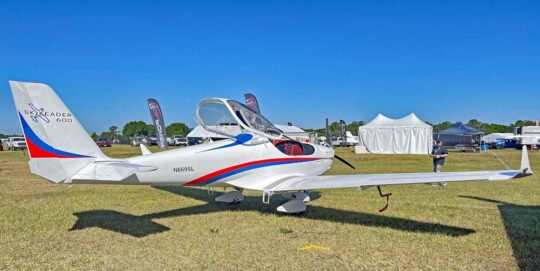 Those LSA veterans may be recalling Kappa KP5, one of the earliest entries on our SLSA List (#9). It was originally sold under the European brand name Jihlavan and that challenging name for Americans may be a good reason the Czech producer changed to the better marketing name, Skyleader.
Those LSA veterans may be recalling Kappa KP5, one of the earliest entries on our SLSA List (#9). It was originally sold under the European brand name Jihlavan and that challenging name for Americans may be a good reason the Czech producer changed to the better marketing name, Skyleader.
For the last few years, Skyleader has been represented by Michael Tomazin doing business as Skyleader North America.
I caught up with Michael at Sun ‘n Fun 2021. He had flown the aircraft clear across the U.S. as he is based on the west coast, in Madera, California. You can hear his description of that jaunt in the video below.
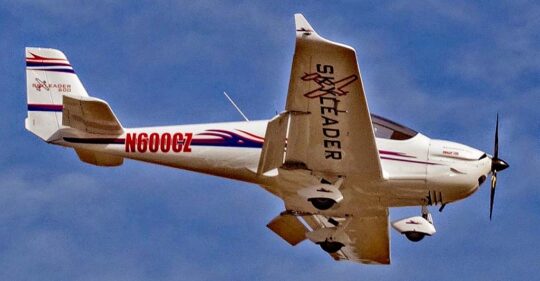 In the interview, Michael also provides other desirable features of the Skyleader 600.
In the interview, Michael also provides other desirable features of the Skyleader 600.
Yet this airplane has a longer background in light aviation and I have reported on it some time back. While my 2008 pilot report is clearly not the latest information much of what I reported in this full-length pilot report remains useful.
That report is typical of what I was writing a decade and half ago. To put this in time perspective, Apple’s iPhone had just come out and no one knew what social media would become. Also, in those days, print magazine ruled the roost and online reporting as I was doing was just gaining genuine traction with readers.
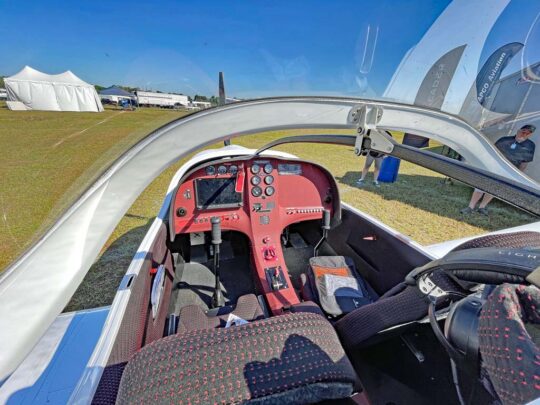
Flight Report Excerpts
(from an earlier evaluation)
Skyleader 500 (now 600, with further refinements) is a handsomely-styled, all-metal LSA with a high-visibility cockpit, a high-performance wing with well-regarded Fowler flaps, tough trailing link landing gear, and a 100-horsepower Rotax 912 engine.
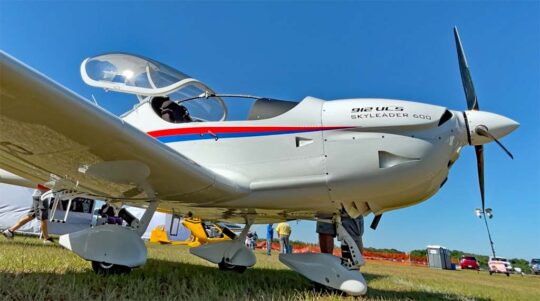
Harmony in the controls is quite good. Pressures are light and response is crisp without being sudden.
I figured rolls from 45° to 45° took about 3 seconds. The Wide Body Skyleader offers very responsive handling with modestly light control forces.
Although the [aircraft of that day] slows down well as proved by my experience with stalls, controls remain very responsive right down to minimum flying speeds. With those Fowler flaps extended well aft, the airplane seems content flying at 45 miles per hour (39 knots).
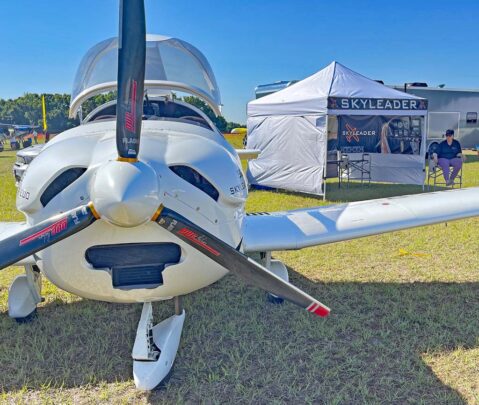
Main gear is very forgiving and feels very sturdy. I had three landings [where the representative] said I tended to raise the nose unnecessarily high, which caused me to plop in on the gear. However, this showed how wonderfully well the gear cushioned my touchdowns.
I performed approach and departure stalls plus accelerated stalls. Most fell to the right a little faster than I’d consider optimal [please remember this was an airplane from 13 years ago], but recovery was always easy. In no case was power required to recover from stall with minimal altitude loss.
After noting the right-hand break, I paid extra attention when I did accelerated stalls to the right. But even with the wing bank at about 45°, the [earlier model] rolled out level, confirming the reasonable stall characteristics of this airplane.
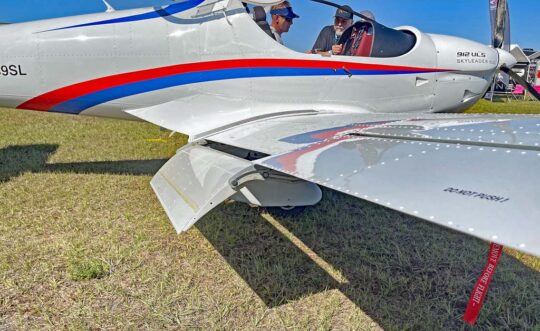
U.S. representative, Michael Tomazin (outside cockpit) shows a prospect around Skyleader 600 at Sun ‘n Fun 2021.
In accelerated stalls, a pronounced burbling identified incipient stall. This was less evident in straight-ahead stalls, but when the nose fell through it proved quite a benign action. All stalls came at very low speeds.
Checking longitudinal stability and disturbing the joystick significantly forward produced a dive speed of about 120 mph (per the Dynon set in mph). In just two oscillations, the [earlier model] had returned to essentially level flight.
Power stability showed that when power was reduced swiftly from level trimmed flight, the [earlier model] dove to 118 Dynon miles an hour… and then quickly leveled out.
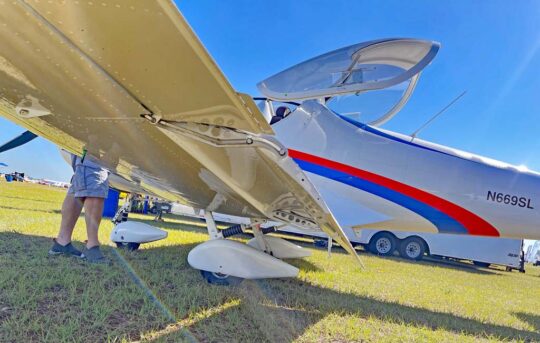
Skyleader 600 is a leading entry in the LSA space but Skyleader North America’s website lists a starting price of $119,595 (in late 2021), making it quite a good value for a high-end entry. The U.S. importer also sells other Skyleader models such as Skyleader 400 starting at $94,595 or the high-wing GP One model starting at $86,899. You will likely want to add options that raise your investment, but at the end of 2021, these are very agreeable — dare I say “affordable?” — prices.
Breaking News — Following up as this article was posted, Michael announced a 400-hour fast-build kit is offered with every component included. Engine, avionics, and wiring harnesses are additional as usual on a kit. A delivered in the USA price of $75,000 will get you well down the road. With avionics (about $14,000 for single screen Dynon, autopilot, ADS-B, transponder, and comm radio) plus engine may list complete for $110,000. All components are fabricagted using CNC machinery so fitting of parts is straightforward and error-free.
TECHNICAL SPECIFICATIONS
Skyleader 600
all data supplied by the manufacturer
- Gross Weight — 1320 pounds / 600 kilograms
- Empty Weight (base equipped) — 705 pounds / 320 kilograms
- Powerplant — Rotax 912 (carbureted); 912iS (fuel injection); 914 (turbocharged)
- Fuel Capacity — 31.8 gallons (198 pounds / 90 kilograms
- Never Exceed Speed (VNE) — 143 knots / 165 miles per hour
- Cruise Speed at 75% power (VC) — 122 knots / 137 miles per hour
- Maneuvering Speed (VA) — 78 knots / 90 miles per hour
- Stall Speed, clean (VS1) ∏— 39 knots / 44 miles per hour
- Stall speed, best flaps (VS0) — 33 knots / 37 miles per hour
- Endurance — 8.5 hours with 30-minute reserve
- Max Range — 860 nautical miles / 1,000 statute mile
- Takeoff Distance — 820 feet
- Takeoff Roll — 330 feet
- Landing Area — 127.5 square feet
- Cabin Width — 4 feet 2 inches
For metric measurements and other information, go to this link



It looks like a good, well designed aircraft. My only concern would be that canopy, which seems susceptible to being ripped off by the slightest breeze. As a glider pilot I’ve seen my share of broken and twisted canopies caused by sudden gusts.
With its slider mechanism, a canopy SkyLeader 600 canopy is less vulnerable to wind gusts than aircraft whose canopies hinge from front or back.
Nice and powerful SLSA. Thanks for the another great article, Dan :).
Well, — I like ’em…
Now if this thing had a high wing design, detachable wings and had it’s tail on the ground where it belongs, I’d be reaching for my checkbook faster than the next snowflake falling… but it does sound like a great airplane…
Dan, have you reviewed the Europa? I’m interested in the plane and may buy one this year. But, that’s not a reason for you to review it. About 25 years in manufacturing, over 500 kits done. The only Mono wheel that I have seen, and it goes 200 mph! with a 100 hp Rotax! This LSA has some unique characteristics. I’m going to Tampa in about 2 weeks to look at a Europa that the Tampa EAA Chapter just rebuilt. They devoted 60 hours to the project, can you do a rebuild in that short a time frame? Anyhow, it is close enough to our Winter address to go take a look. Thanks, Dan. I’ll check back with you.
I did review the Europa but it was so many years ago that the article did not make it into digital media. I found it a great motorglider-type aircraft with some purposeful construction, such as that center mono wheel (done to facilitate off-airport landings given high landing fees at British airfields). It’s impossible for me to comment on how much of a rebuild can be done in 60 hours. An EAA chapter lends great credibility to the project but, of course, it’s a buyer-beware purchase.
You say all the planes you review are great…
For the most part, they are quality aircraft. I do point out things I don’t care for as much and I certainly report any major deficiencies I find. The good news is that many of these airplanes are great, but that may not mean YOU like them. I can’t do that part. Thanks for reading!
Interested.